Class 116 Derby 3-car Suburban DMUs
Description
During May 1957, Derby was producing six cars per week. Completed sets noted in Derby on the 17th April 1957 were 50051/2, 59001/2 and 50093/4.
A Class 116 car was the 500th diesel railcar to be built at the Derby C&W Works. It was completed in January 1958 and featured in publicity pictures.
The cars kept the same 'Derby' front end as the Class 114, but changed to the high density layout for their suburban use. This entailed carrying large numbers of people over short distances, so no gangways or toilets were fitted when built.
The body and roof framing were of conventional BR design, in 'top hat' section, with the cab roof made of moulded polyester glass laminate. Insulation was with asbestos (though to be in just the first two of the three batches).
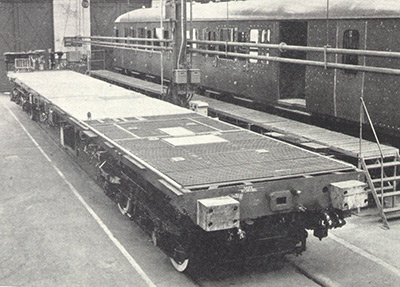
The underframe was of a mild steel welded construction. The standard Derby DMU bogies had Timken roller bearings. The Gresham & Craven quick release vacuum brake system was fitted. The picture shows the almost completed bottom end of a vehicle. Even the cab desk was almost complete, before the jig built sides and ends are added.
Large round Oleo buffers were carried from new although during the 1970s and early 1980s, a number of sets ran with the oval type, before reverting back to the large round type. A few units (mainly from the last batch) were fitted with the oval type in the early 1960s.
The standard BUT power train and control equipment was used with 150h.p. engines, the majority having the Leyland type. Just three sets were delivered with the AEC type (power cars 50859-61 and 50912-4). The power/weight ratio was 6.3 : 1. The exhausts originally joined above the gangways, emitting through a single box as visible on Class 122s when new.
The Birmingham sets were fitted with ATC from new.
Although toilets were never fitted to the trailers, in the 1980s displacement of similar trailers of Classes such as 127 which had toilets saw them replace the 116 trailers.
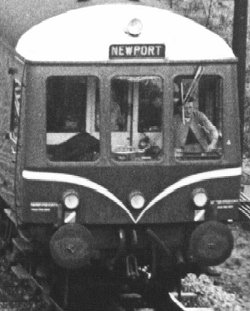
Coupling Codes
The Class was the standard Blue Square, although for a short spell one set was Blue Square with diagonal stripe, due to the final drive having a different gear ratio. This was in November 1958 when a set was fitted with final drives with a lower gear ratio than standard to assist operation on the steeply graded eastern valley services out of Newport. The set, CAT404 W50086/W59036/W50128 could not operate in multiple with the standard units and as a consequence it’s blue square coupling code was given an additional mark in the form of a cream diagonal bar to indicate this to operating staff, and accompanying warning. It was restricted to 55mph. Dedicated to these services until the closure of the eastern valley network to passenger services on the 30th April 1962, the low ratio gearing on this set was later returned to standard.
Marker Lights
The first batch of vehicles had the four lamp arrangement (and just one windscreen wiper). The later ones received a two-character headcode box below the centre cab window, with just two lamps, one either side. Just the last batch received two windscreen wipers from new, but the earlier sets had a second added later.
Inner Ends
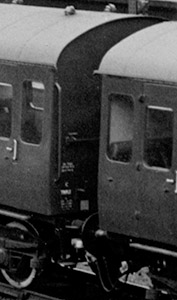
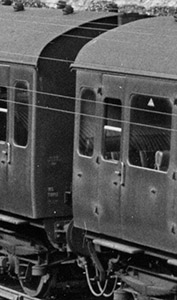
Built without gangways, the inner ends were pretty plain, just flat panels. All had lamp brackets just above the buffers, power cars had the exhaust pipes which originally joined together into a box just below roof height. One end of the centre car had a handrail on each side, aiding access to the lighting control from track level, this was a horizontal bar connecting handles just above waist height. The other end would have the 'butterfly' at gutter height to reset emergency chain, this would just require a handrail and additional footstep on the right side of the vehicle.
Text carried on the ends included the usual data (weight, dimensions and seating), the vehicle type / formation - as delivered this was MBS, MS or C and 'TRIPLE', and shopping details.
Seating

To give maximum seating capacity, the high density design was used. With doors at each seating bay there was no need for gangways or a through corridor. The image shows the front saloon of a power car. The DMS had solid partitions (no doors between saloons), and although the DMBS did have a doors in the partitions, this was purely so the guard could get to the driver, and as it was considered that the limited gap between the seats were not designed for public passage, the staff were instructed to keep these doors locked.

The Tyseley sets were fitted with route maps above passenger doors, as seen in the image taken on August 25, 1960. Michael Mensing.
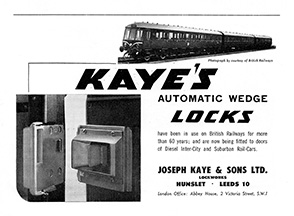
This advert from Joseph Kay & Sons Limited for their Kaye's automatic wedge locks features an image of a Class 116.
Summary
Description
Modifications
Works Photographs
Diagrams
Numbering
Drivers Instructions
Liveries
Operations
- South Wales
- Scotland
Accidents
Railair Express Parcels set
Parcel Use
Refurbishment
Hybrids
Decline
Departmental Use
Images
Details about preserved Class 116s can be found here.
Thanks to Mac Winfield, Ian Fleming and John Thomlinson for much of the information on this Class.


